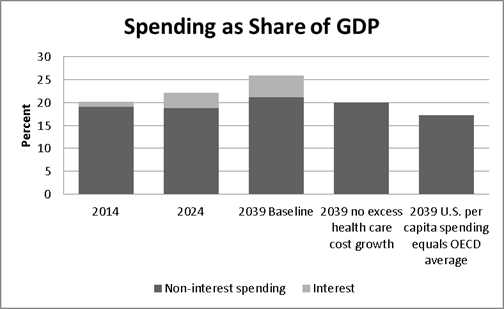July 16, 2014
The deficit hawks will undoubtedly find much to hype in the latest long-term projections from the Congressional Budget Office (CBO). After all, they move forward by a year to 2030 the date of the Social Security trust fund’s depletion. That should be worth a quick war dance down at the Peter G. Peterson Foundation, but there are a few items worth noting for more serious folks.
First, most of the projected rise in the annual deficit between 2014 and 2039, is due to an increase in the interest burden from 1.1 percent of GDP in 2014 to 4.7 percent of GDP in 2039. This increase is mostly due to the assumption that the average interest rate on government debt will rise since the debt to GDP ratio is projected to be just 40 percent higher in 2039 than it is today. The assumption of higher interest is at least peculiar in the slow growing economy projected by CBO. If interest rates remain closer to current levels, then the story of exploding deficits/debt largely vanishes.
The other point is that this is overwhelmingly a health care story. The figure below shows the projected levels of spending in 2014, 2024, and 2039. It also shows an alternative scenario for 2039 that assumes age adjusted spending on health care just grows at the same rate as GDP. A final scenario shows spending assuming that per capita health care spending falls to half of its projected level, bringing it in line with the average for other wealthy countries.

Source: Congressional Budget Office and author’s calculations.
In the projections that assume no excess health care cost growth, projected non-interest spending is 20.0 percent of GDP, less than 1.0 percentage point above its current level. That hardly seems like the sort of crisis that need to bother people 25 years ahead of time. In the case where per capita health care costs fell to their OECD average non-interest spending is 17.2 percent of GDP, considerably less than current spending.
Given these numbers it is striking that the Peterson types always focus on cutting programs like Social Security and Medicare rather than reducing health care costs. The latter involves bringing what we pay for doctors, drugs, and medical equipment more in line with the rest of the world. This is very difficult to do given the enormous political power of these groups. Of course it is also politically difficult to cut programs like Social Security and Medicare which provide essential support for most retirees.
The Peter Peterson deficit hawk gang apparently feels more comfortable trying to beat up on the country’s workers rather than the doctors, drug companies, and medical equipment suppliers. This reflects their political preferences not the objective facts about the federal budget.
One other point that is worth noting is that CBO projects that average hourly compensation will be more than 40 percent higher in 2039 than it is today. If typical workers get their share of this growth, they will enjoy considerably higher living standards than do workers today. That would be true even if payroll taxes were increased by two to three percentage points.
However it is far from clear that ordinary workers will share in the gains from growth. If the pattern of the last three decades continues then most of the gains from growth will go to high end workers and corporate profits. If that proves to be true, the consequences for the living standards of our children and grandchildren will be far more serious than any plausible increases in the payroll tax. The fact that discussions of “generational equity” always focus on the payroll tax rate and almost invariably ignore the pre-tax distribution of income shows the distortion of reality in national politics and the media.






